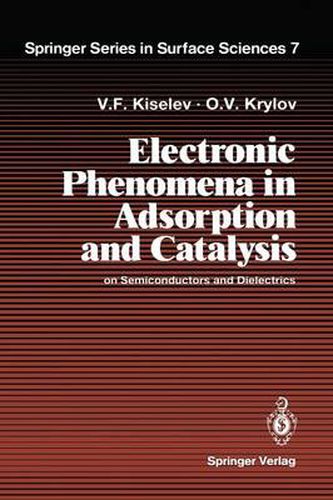Readings Newsletter
Become a Readings Member to make your shopping experience even easier.
Sign in or sign up for free!
You’re not far away from qualifying for FREE standard shipping within Australia
You’ve qualified for FREE standard shipping within Australia
The cart is loading…






This title is printed to order. This book may have been self-published. If so, we cannot guarantee the quality of the content. In the main most books will have gone through the editing process however some may not. We therefore suggest that you be aware of this before ordering this book. If in doubt check either the author or publisher’s details as we are unable to accept any returns unless they are faulty. Please contact us if you have any questions.
It is now firmly established that various adsorptive and catalytic processes taking place on the surface of semiconductors and in MIS structures strongly influence their electronic properties and hence modify the parameters of semi conductor devices. The inverse problem of how the semiconductor’s electronic subsystem influences adsorption and dissociation of molecules at the surface has been recognized but much less explored. The main purpose of the present book is to generalize the experimental data and explain the relationship be tween these two classes of phenomena. We also discuss tentative models of surface electronic states and their interaction with adsorbed molecules. The subject of this book should attract the attention of researchers work ing in the overlapping areas of physics and chemistry, and of physics and biology. The research done in this field will help to widen the scope of semi conductor applications by finding novel ways of employing surface effects in the construct ion of mi croe 1 ectroni c devi ces, semi conductor gas ana lysers, solar cells, etc. The authors hope that this book will be useful to a wide circle of chemists and physicists concerned with the study of interphase phenomena and questions of adsorption and catalysis. Certain parts of the book will be helpful to physicists and technicians working in rapidly developing branches of semicon ductor physics and technology. The book can also serve as a textbook for both under- and postgraduates speci al i zi ng in thi s fi e 1 d.
$9.00 standard shipping within Australia
FREE standard shipping within Australia for orders over $100.00
Express & International shipping calculated at checkout
This title is printed to order. This book may have been self-published. If so, we cannot guarantee the quality of the content. In the main most books will have gone through the editing process however some may not. We therefore suggest that you be aware of this before ordering this book. If in doubt check either the author or publisher’s details as we are unable to accept any returns unless they are faulty. Please contact us if you have any questions.
It is now firmly established that various adsorptive and catalytic processes taking place on the surface of semiconductors and in MIS structures strongly influence their electronic properties and hence modify the parameters of semi conductor devices. The inverse problem of how the semiconductor’s electronic subsystem influences adsorption and dissociation of molecules at the surface has been recognized but much less explored. The main purpose of the present book is to generalize the experimental data and explain the relationship be tween these two classes of phenomena. We also discuss tentative models of surface electronic states and their interaction with adsorbed molecules. The subject of this book should attract the attention of researchers work ing in the overlapping areas of physics and chemistry, and of physics and biology. The research done in this field will help to widen the scope of semi conductor applications by finding novel ways of employing surface effects in the construct ion of mi croe 1 ectroni c devi ces, semi conductor gas ana lysers, solar cells, etc. The authors hope that this book will be useful to a wide circle of chemists and physicists concerned with the study of interphase phenomena and questions of adsorption and catalysis. Certain parts of the book will be helpful to physicists and technicians working in rapidly developing branches of semicon ductor physics and technology. The book can also serve as a textbook for both under- and postgraduates speci al i zi ng in thi s fi e 1 d.